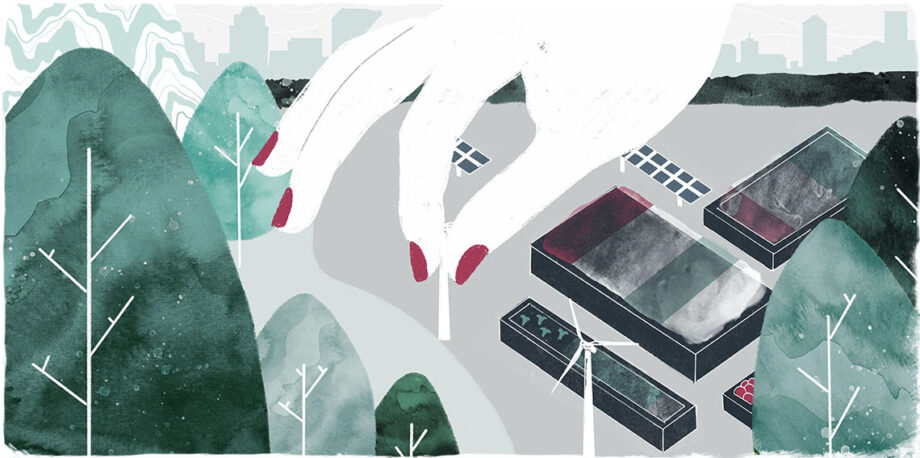May 19, 2016 — Just as I was putting pen to paper for this piece I was amused to receive an invitation from a wonderful organization called “Julie’s Bicycle” to an event with the compelling title: “How to be a COPtimist: Culture, Creativity and COP21.”
Optimism regarding the state of the planet in the face of climate change is in understandably short supply these days. Most of those who know the science (really know the science) see optimism as an illusionist’s bolt-hole. And most of those who’ve followed things at more of a distance feel very jaundiced at the failure of today’s political establishment and the increasingly offensive greed of today’s business élites.
But without hope (which I prefer to optimism), it’s next to impossible to persuade people to stir themselves into action rather than sitting on the sidelines rehearsing all the different ways there are of saying, “I told you so.”
Instead of portraying the future Earth as a polluted, overpopulated hellhole, we must show it as a place where we would all love to live.
It was that psychological impasse that set me on the trail of what became The World We Made, published in 2013. My conviction — now and as I wrote the book — is very simple: Instead of portraying the future Earth as a polluted, overpopulated hellhole, we must show it as a place where we would all love to live: exciting, aspirational, high-tech, fair and hopeful.
The World We Made is told through the words of Alex McKay, a history teacher looking back from 2050, trying to understand how we got from the world as it is today to a much more compelling world in which:
- 90 percent of energy comes from renewable sources and 30 percent of electricity from solar power
- standard tech devices are computing at the same rate as the human brain
- nanotechnology, 3-D printing and biomimicry have transformed the world of manufacturing
- personal genomics allow everyone to manage their own health, live longer and healthier lives, and die when they want to
- there are still rich and poor, but the rich are poorer but happier, and the poor are richer in so many ways.
The point of The World We Made is that we pretty much have all the technological firepower we need to move from being inherently and hopelessly unsustainable today, to a more or less sustainable world by 2050. When I try and persuade skeptics that this is not just a pipe dream, my favorite analogy is that of Pearl Harbor. Until Japan attacked the United States, most of the manufacturing base in the U.S. was focused on consumer goods. Within nine months, much of this productive capability was converted to making the weapons of war. For instance, not one private car was produced between 1942 and 1945.
Without this kind of positive vision, we become more and more disempowered. Yet most environmental problems (apart from species extinction) are theoretically reversible if and when we get our act together. People often cite our relative success in restoring the ozone layer over the last 25 years or so as a measure of what we can do when we put our minds to it.
Climate change, however, is a very different story, not least because there is indeed a point where it becomes all but impossible to slow increases in average temperatures. Which brings us neatly back to the 21st session of the Conference of the Parties in Paris — COP 21 — at the end of last year.
You may think the difference between 2 °C and 1.5 °C doesn’t sound like much. However, the difference is massive. By near-universal agreement, this was a pretty extraordinary event, where, for the very first time, world leaders seriously got their heads around the threat of runaway climate change. They confirmed the need for every country to do everything in its power to limit the average temperature increase by the end of the century to no more than 2 °C (3.6 °F) — and then, even more remarkably, to aim for an even lower threshold of 1.5 °C (2.7 °F).
You may think the difference between 2 °C and 1.5 °C doesn’t sound like much. However, the difference is massive. Forget about targets and deadlines and so on, and just think about carbon budgets, the metric climate scientists prefer. Here’s what 1.5 °C means from a carbon budget point of view: Scientists have calculated that we can put no more than 650 billion metric tons (720 billion tons) of carbon into the atmosphere if we want to stay below that 1.5 °C threshold. Since the mid-19th century, we’ve already put 550 billion metric tons (610 billion tons) into the atmosphere, leaving a residual “budget” of just 100 billion metric tons (110 billion tons). At the moment, we emit about 10 billion metric tons (11 billion tons) per year. Which means, putting it as starkly as people need to hear it, our remaining budget will be all used up in just 10 years’ time.
I doubt that a single world leader understood the implications of that in Paris. But they will by 2020. Every nation, rich or poor, will by then understand the imperative of moving toward an ultra-low-carbon economy as fast as possible.
Take transport, for starters. What would that look like in practice? By 2030, working together, governments and city mayors will have to have eliminated new sales of all petrol and diesel vehicles. Almost all vehicles (buses, cars, taxis, vans, trucks, etc.) will need to be either electric or hydrogen-powered. Absolute priority will need to be given to cycling and pedestrian infrastructure.
For the first time in a very long time, the air people breathe will then be unpolluted. Thousands of deaths and hundreds of thousands of hospital admissions will have been avoided. Streets will be safer; kids will play outside across areas zoned primarily for people, not for cars. Suburbs will be “re-greened,” with more space set aside for trees, parks, city farms and mini-market gardens.
For all the problems of today’s market economy, markets are powerful drivers of change.That was the kind of alternative I mapped out in The World We Made — for transport, energy, manufacturing, farming, water, waste and so on. And practically everything I pointed to at the time really has started to emerge in practice — including the Pope becoming one of the world’s outstanding leaders in advocating for a “just transition” to an ultra-low-carbon society.
For all the problems of today’s market economy, markets are powerful drivers of change. Just look at the astonishing uptake of solar technologies across the world as prices have come crashing down over the last few years. Just look at the speed with which the coal industry is now heading into a death spiral, unable to cope with competition from gas and renewables.
And just look at the way Elon Musk’s crusading drive to get a US$35,000 Tesla into the market by the end of next year has revolutionized people’s expectations of the future of the car industry — with giants like Toyota and GM now intent on matching Tesla every step of the way.
The enemy of hope is not despair, but indifference. Post-Paris, we have a chance to change the “mood music” about the extraordinary benefits of a genuinely sustainable world, pointing out not only that it’s absolutely necessary to move in that direction, but that to do so will be both exciting and desirable. That’s what we mean by COPtimism! ![]()
Editor’s note: The views expressed here are those of the author and not necessarily of Ensia. We present them to further discussion around important topics. We encourage you to respond with a comment below, following our commenting guidelines, which can be found here. In addition, you might consider submitting a Voices piece of your own. See Ensia’s “Contact” page for submission guidelines.
Ensia shares solutions-focused stories free of charge through our online magazine and partner media. That means audiences around the world have ready access to stories that can — and do — help them shape a better future. If you value our work, please show your support today.
Yes, I'll support Ensia!

It's easy if you try
No hell below us
Above us only sky
Imagine all the people
Living for today... Aha-ah...
Imagine there's no countries
It isn't hard to do
Nothing to kill or die for
And no religion too
Imagine all the people
Living life in peace... You, ..
You may say I'm a dreamer
But I'm not the only one
I hope someday you'll join us
And the world will be as one
Imagine no possessions (for YOU)
I wonder if you can
No need for greed or hunger
A brotherhood of man
Imagine all the people
Sharing all the world...
Tragedy of the Commons and Finite Resource analyses suggest that your goal is unattainable with a world population of only 2 billion at a standard of living equivalent to Italy or Japan, much less the 10 billion plus projected for 2050.
"Hope is not a strategy."
But this sacrifice does not worth more then our human race ,our life
So lets keep it simple